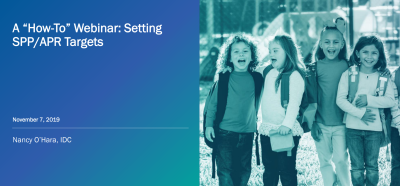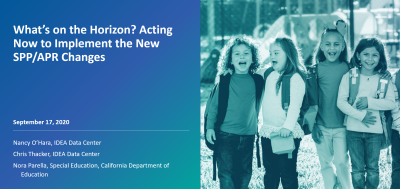Site Search
Results 1 - 7 of 15
-
A “How-To” Webinar: Setting SPP/APR Targets
According to the Office of Special Education Programs (OSEP), all states must set targets for the State Performance Plan/Annual Performance Report (SPP/APR) indicators through FFY 2019. During this webinar, an IDC TA provider first detailed the requirements for SPP/APR targets. Then, the TA provider described specific methods states can use to set their targets. The webinar concluded with a discussion among state participants about strategies they have used to involve stakeholders in the target setting process.
-
What’s on the Horizon? Acting Now to Implement the New SPP/APR Changes
Join our knowledgeable IDC staff, Nancy O’Hara and Chris Thacker, as they guide you through the changes to the State Performance Plan/Annual Performance Report (SPP/APR) collection that will establish a new 6-year cycle for collecting and reporting IDEA data. The presenters explained the new requirements and shared implications for data collection, analysis, and use. A state speaker shared strategies their state is implementing now to meet the new requirements and ensure the state will have high-quality data for reporting for the FFY 2020 SPP/APR. This interactive webinar provided an opportunity for states to contribute their ideas and planned strategies to prepare for their SPP/APR due in 2022.
Format: Guides and Briefs
Success Gaps Rubric: Addressing Equity, Inclusion, and OpportunityThis rubric allows a team of users from a district or school to systematically examine the root causes of success gaps among groups of students by focusing on equity, inclusion, and opportunity. The recently updated rubric now includes considerations for children as young as preschool age. A complementary white paper provided the research-based background that supported development of the rubric.
Format: Toolkits
Success Gaps Toolkit: Addressing Equity, Inclusion, and OpportunityThe Success Gaps Toolkit presents a process for using data and the Success Gap Rubric to identify root causes of gaps between groups of children in districts or schools. These success gaps occur when the education system is not meeting the needs of all groups of children and outcomes for some groups are different than outcomes for most groups. The toolkit, with its process and materials, provides a manageable and defined way for districts or schools to identify success gaps that are present and their root causes and then make a plan for addressing the gaps. The success gaps may be the graduation rate of students who are English learners compared to the rate of all other children, the out-of-school suspension rate of children who are Black compared to the rate of all other children, the identification of children who are Hispanic as children with specific learning disabilities compared to the identification of all other children, and other gaps.
Format: Toolkits
SEA Data Processes ToolkitUsing the SEA Data Processes Toolkit to document data processes for all 616 and 618 data collections will establish a well-managed process for data collection, validation, and submission. In collaboration with IDC State Liaisons, states can use the toolkit to create and maintain a culture of high-quality data and establish and support consistent practices that produce valid and reliable data, while building the capacity of state staff.
Format: Applications and Spreadsheets
Equity Requirements in IDEAThis resource compares the three equity requirements in IDEA (disproportionate representation, significant discrepancy, and significant disproportionality) across various elements to explain the similarities and the differences among the requirements.
Format: Guides and Briefs
Examining Representation and Identification: Over, Under, or Both?Significant disproportionality with regard to identifying children as children with disabilities or as children with specific disabilities is, by definition, overrepresentation. This resource defines overrepresentation and three related terms: over-identification, under-identification, and underrepresentation. States can use this resource, in conjunction with the Success Gaps Toolkit to help identify and address the factors contributing to significant disproportionality (i.e., overrepresentation) within school districts.







